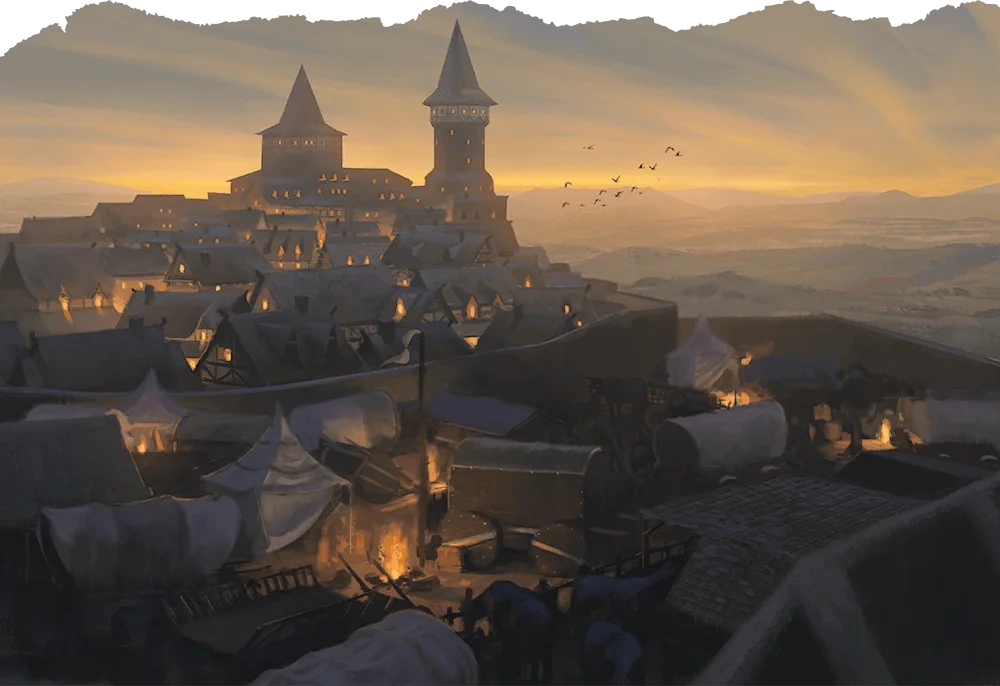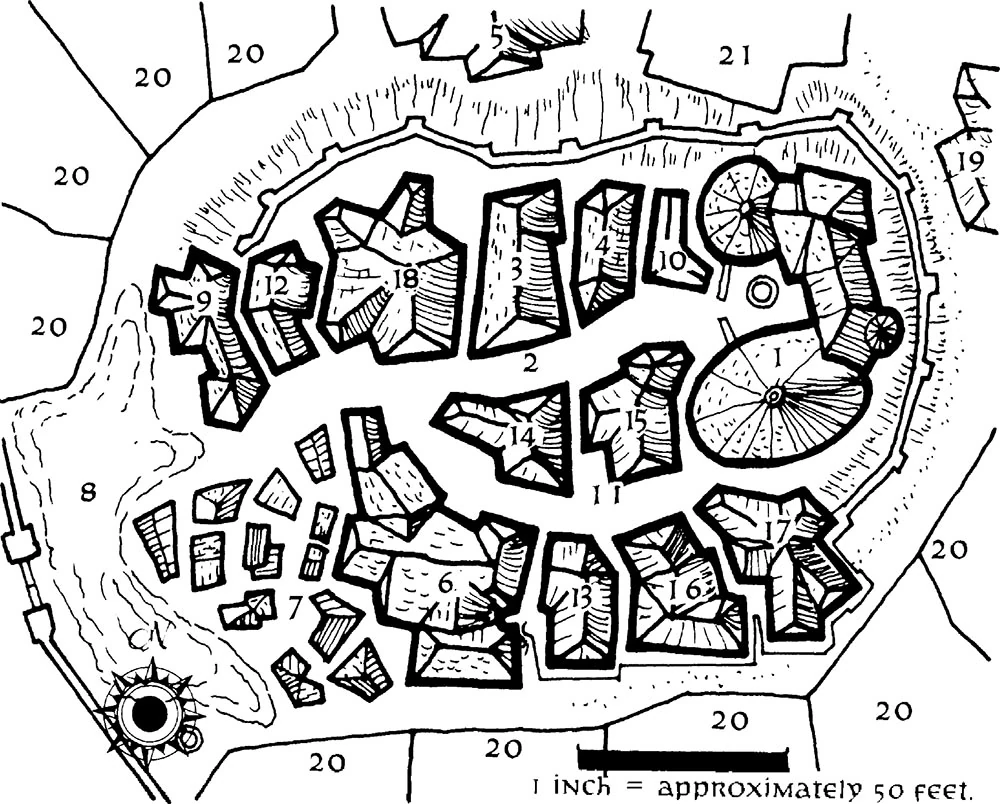Bargewright Inn
Bargewright Inn was a hilltop settlement on the River Dessarin in the Savage Frontier that grew up around the inn of the same name. In the mid-to-late 14th century DR, it was not a true village nor even a hamlet, but rather an assemblage of businesses that had based themselves at a vital crossing to service travelers and later farmers and ranchers who had settled along the river's west bank. These made it an important wayside hub and sanctuary for travelers of all sorts. In the late 15th century DR, it remained much the same, but a much larger and full-fledged settlement.
Demographics
Circa 1358 DR and through the 1360s DR, it had a permanent population of only 35 people. However, in the summer when business was good, its transient population could swell to 750, though they would be gone in the morning.
Government
In the mid-to-late 1300s DR, Bargewright Inn was managed by a Council of Directors. Initially, the founder and innkeeper Feston Bargewright was the chairman around 1358 DR, but he was later replaced by his brother, the stablemaster and militia commander Aldon Bargewright by 1370 DR. Nevertheless, Feston remained a key member and representative of the council.
In the late 1400s DR, an alliance of local business owners still managed Bargewright Inn in a plutocratic government and a descendant and namesake, Feston Bargewright, remained as innkeeper.
Show spoiler
. Senior Sword Chalaska Muruin, who commanded the gate guards, was the unofficial head of the settlement, while the Old Bargewright's innkeeper was now one Nalaskur Thaelond.
But with the majority of them having financial dealings with the Zhents, by 1491 DR, the Zhentarim had effectively taken over the settlement. They kept their ownership secret so as to escape prying eyes
Law & Order
There was little in the way of law and order in the 1360s DR. Merchants here carried the crook-topped staves as a symbol of authority and anyone defying them within Bargewright Inn's walls was summarily expelled from the compound.Defences
The settlement was surrounded by two concentric walls, one around the base of the hill, the other around its top. It also sported two towers, the North Tower and the South Tower, both part of the inn and looking over the surrounding grasslands. In the 1490s DR, the concentric walls were higher and the towers had been rebuilt, and included an gate and postern in the outer wall and two gates in the inner wall. The two towers were not just used for defense: the southern tower held meeting rooms, while the northern had a strongroom at its base, used to store the Zhentarim's pay, riches, loot, and other items of importance.
The settlement was defended by a militia. In the mid-to-late 1300s DR, these comprised five trained fighters (hostelers at the inn) and a score of shopkeepers all wielding pikes and were led by Aldon Bargewright. They would muster in the event of a raid by bandits, orcs, or trolls. If adventurers happened to be staying in Bargewright Inn at the time, they would be requested to lend blade or spell to the defense for a reward of 1 gp per person and free stay at the inn for the following tenday. In the late 1400s DR, the militia was named the Swords, led by Senior Sword Chalaska Muruin, and numbered forty guards.
The gates were manned by two humorless gatewardens who would question visitors about their activities. Once reassured a traveler had legitimate business, they would let them in and give them basic directions and an overview. They were armed with Bargewright Inn's characteristic staves with a metal crook on top and a studded metal goad at the bottom. The gates were the only entrance and at nights they were shut and barred. After sunset, chairs hung from ropes could be lowered over the walls from a few of the houses at nights for the high price of 4 to 6 gp per person, and no more than the person could carry.
Industry & Trade
Bargewright Inn provided a variety of services to travelers; around 1358 DR, these included the inn, tavern, a shop selling dry goods, a wagonwright who repaired wagons, a pharmacist to treat pack animals, even a combined temple and festhall available for hire in the form of the House of Good Cheer. The selection remained much the same in the 1490s DR but larger, with multiple blacksmiths, coopers, wagonwrights, and wheelwrights, as well as traders in oxen, mules, and horses, and inns, stables, and warehouses.
Fresh manure from the rented paddocks and stables was collected and loaded onto carts for a fee of 1 cp per cart. This was transported to local farms for use as fertilizer.
Around 1491 DR, Bargewright Inn relied on barges coming regularly down the River Dessarin from Yartar for its supplies. This included such things as food, beverages, leather goods, sheaths, nails, buckles, and swivel-rings.
History
Once, this was but the site of a simple wayside inn standing alone atop a hill beside the ford. However, after numerous attacks from bandits and brigands, Feston Bargewright, the innkeeper, elected to fortify the hill. This feat was accomplished with the help of several Waterdhavian merchants whom Feston had encouraged to join him to share the costs. Being weary of the politics and fees of the city's guilds, they came and established other businesses servicing the travelers and caravans passing through. Bargewright Inn was well-established by 1358 DR.
Some time in the mid-1350s DR, a Black Dragon descended on Bargewright Inn with the intent of assaulting the settlement. According to local legend, the festhall owner Tabra jumped off her bedroom balcony, transformed midair into a dragon herself (those who tell the story disagree on the type), and chased it off. True or not, Tabra hated the tale and angrily evicted anyone who dared repeat the story in her earshot.
Despite the notoriously boring nature of Bargewright Inn, the drow-dragon Nurvureem, the Dark Lady, based herself there for two whole seasons and made her own entertainment, causing chaos across the North. Eventually, the Harpers enlisted the aid of an Eilistraean drow priestess to help drive her out. They confronted her, but she raged and screamed and fled into the wilderness.
Brin and Havilar visited Bargewright Inn on Ches 21, the Year of the Nether Mountain Scrolls, 1486 DR. They went to the inn and negotiated with the later Feston Bargewright to use the Harper portal to reach Noanar's Hold.
A few years later, the settlement and many of its businesspeople fell under Zhentarim influence, but the Black Network kept their presence covert so as to escape attention.
In the Year of the Scarlet Witch, 1491 DR, the Ranger Melisande Calador visited Bargewright Inn and stayed at the inn, as did the famed minstrel Harrowind of the Windwyrds. That year, the supply barge from Yartar was delayed and Nalaskur went to Waterdeep to acquire more supplies and speak with his superiors in the Zhentarim, leaving control of The Old Bargewright in the hands of trusted others. This triggered a struggle for power amongst the Zhent leadership, instigated by the Zhent spy Inglor Brathren, involving thefts of Chalaska's keys and gold from the Zhents' strongroom. Nalaskur returned to find the settlement in conflict. Supplies issues continued: one month's was late, understocked, and overpriced. The Zhentarim of Bargewright Inn suspected intrigue in Yartar, not realizing it was the Kraken Society waging their struggle for power with the Waterbaron there. This time, the Zhents launched not one but two trade expeditions to Triboar: one by barge, one by caravan.
Later, the thieves Edgin Darvis, Holga Kilgore, Simon Aumar, Kira Darvis, and Forge Fitzwilliam dared pose as Zhentarim and attempt to steal gold from one of their wagons on the outskirts of Bargewright Inn sometime in the 1490s DR. However, their Zhent leader, a mage, saw through Kira's pendant of invisibility, attacked the would-be thieves, and escaped with the gold, threatening to put a bounty on them as he did. The rogues went onto Womford.
Points of interest
Architecture
The Bargewright Inn of the 1360s DR was a small and austere place with little of note going on. A curious visitor like Volothamp Geddarm could see and do all that was here before highsun if they tried, and be thoroughly bored if forced to stay for more than two days. From afar, it appeared to be a rundown hilltop castle with two towers: the first tall and slender, the second short and thick and distinctly tilted. Two concentric walls circled the hill and contained the buildings scattered around the slopes. A single set of gates on the western edge was the only entrance. By the l490s DR, it had grown much but changed little, now covering the hill with its ramshackle and regularly rebuilt buildings and towers constructed of wood, all surrounded by a wall and under a pall of smelly manure and mud.
Layout
In the 1360s DR, the lower part of Bargewright Inn was the space between the walls. Just inside the gates was an area called simply 'the Mud', for obvious reasons. It was a great stretch of dirt and dung, well trampled by the beasts brought within the walls, that lay at the start of the road that meandered up the slope. Around the base of the hill, within the outer wall, were a number of paddocks that were available to rent at 5 cp per day, from highsun to highsun, and they held about forty animals each. In these, caravans could make camp and drovers could keep their stock prior to sale or to rest before continuing onto Waterdeep. Above the Mud in the west were 'the Stalls', a market where local farmers sold their produce; they could rent an awning, bench, and table, including a bucket of water, for only 1 cp a day. Finally, around the north side was the stables servicing guests of the inn. Volo complained the area smelled heavily of manure, unsurprisingly. To reach the upper part, one could take the single street that ran up the spine of the hill. This was the long, safe option. The quicker, less safe options included a rather unsteady rope-lift elevator leading from the stables to the inn and a hazardous zig-zagging stairway up the rocky northern face of the hill. In the upper part of Bargewright Inn, the main street known as 'the Rise' was flanked by the various businesses and stopped in a courtyard in front of the Bargewright Inn itself. Leading off the Rise was a side street called just 'the Back', which ran amongst the homes of the people who actually lived here. It ran precipitously along the hill's edge and some of the southernmost houses even hung over the edge and above a livestock path in the lower parts. These houses were half-supported by pillars and provided some shelter against the rain to drovers beneath them. Two wells provided water to the community. The first stood in the courtyard in front of the inn on top of the hill; it ran deep. The second was among the paddocks in the south; it was used to pump water into animal troughs for 1 cp for one trough and was kept covered and locked.Geography
It was built atop a natural hill on the west bank of the River Dessarin at the crossroads of trails leading to Red Larch in the north (the Cairn Road), Amphail in the west, and over the river at the Ironford Bridge in the east to the nearby village of Womford that it overlooked and the beginning of the Iron Road. To the south of Bargewright Inn was Goldenfields.
The hill had a rocky northern face, and smoother slopes around the other sides.
Type
Outpost / Base
Population
~750
Included Locations
Owning Organization
Characters in Location





Comments